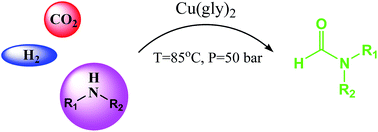An efficient copper catalyzed formylation of amines utilizing CO2 and hydrogen†
Abstract
Trans-Bis-(glycinato)copper(II) complex was found to be a highly active, economical and efficient heterogeneous catalyst for the formylation of amines utilizing CO2 and hydrogen under solvent free conditions.


 Please wait while we load your content...
Please wait while we load your content...